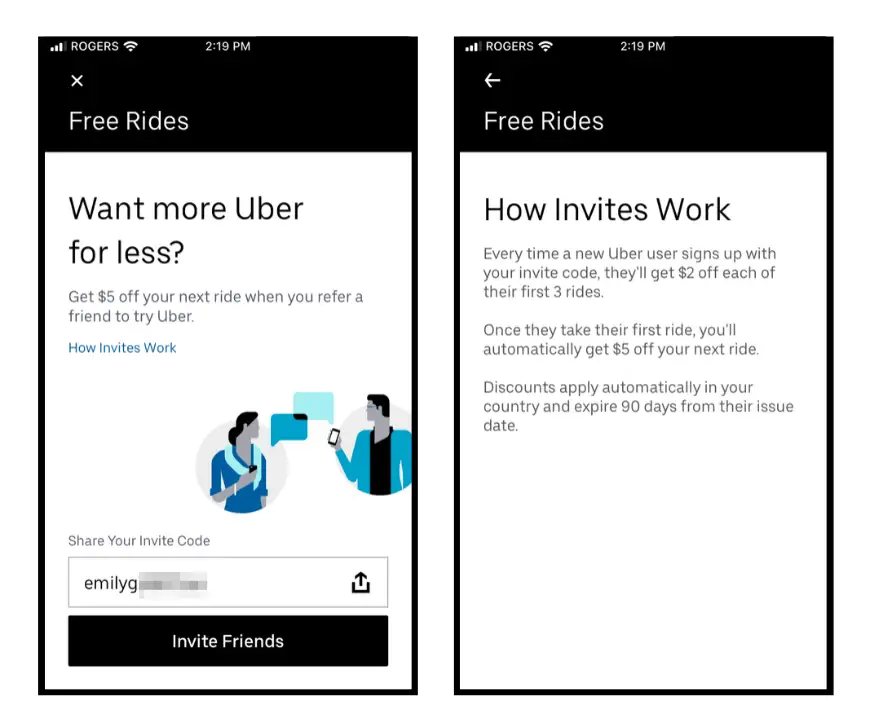You may consider referral marketing a piece of technology or a stand-alone feature. The reality? Word-of-mouth marketing is a full-blown marketing channel—one that’s cost-effective and puts your loyal fans at center stage. Research shows that 50% of people trust recommendations more than online banner ads, mobile ads, SMS messages, and SEO ads.
The union between technology and marketing strategy is crucial in establishing a successful referral program.
The core of any referral program relies upon a few key elements—an attractive reward system, a focus on new customer benefits, and a robust initial offer. The right referral technology can help put these actions into progress.
Here’s a peek under the hood of a referral program so you can plan, execute, and grow customers into strong advocates for your brand.
The nuances of setting up and managing a referral program
It’s a common misnomer that referral programs are ‘fire-and-forget’ campaigns. However, these programs require consistent optimization and customer engagement. Offer customer-aligned rewards, easy-to-use referral processes, and build campaigns that resonate with customers.
Plan your reward structure around what your customer wants
Choosing the right rewards for your customers is one of the most important aspects of a successful referral program. Build a strategy based on customer feedback and carefully evaluate incentives for your industry. Here’s what we recommend:
Speak to your customers
Marketers’ biggest mistake in referral marketing is not speaking to their customers. Engaging with customers in a meaningful way will give you greater insight into what rewards would entice them.
Some rewards work better than others. For instance, research shows that giving a reward tied to the brand (percent discount, points, gift cards) drives more referrals than giving a cash payout. However, sometimes using a third-party reward makes more sense.
For example, mattresses aren’t something you buy often. If a person just bought a mattress, they won’t be interested in a $100 credit for another mattress. In this case, a third-party reward like an Amazon or Visa gift card would be better.
Think about who to reward
In single-sided programs, rewarding the referred customer vs. the existing customer attracts more new customers.
Think about it—the recipient (new customer or user) needs the reward. They’re the ones who are going to try something new. It makes sense to encourage existing customers to refer their peers, but if they’re already purchasing your product or service, they most likely love your brand. So, they need less motivation to say good things about it. Plus, getting a reward for their loved ones and peers can increase their social standing with them.
Get the reward value right
You may feel tempted to keep reward values small. While you don’t want to break the budget with an unrealistic reward value, you still need to offer enough to pique your audience’s interest.
Common reward types and values for various industries:

The team at SaaSquatch by impact.com has found that brands should start with a moderately high value and lower it as the program garners more attention. For example, Uber initially offered a $20 dual-sided reward for riders. As the app became more of a hit, it decreased the reward value to a minimum of $2 off users’ first three rides and a $5 reward for the referrer.

Factors like reward values can change over time. Using sound technology allows you to make these changes regularly without hassles.
Make widgets customer-friendly by continually adjusting and testing
Put yourself in your customers’ shoes. You’ll probably push it aside if you have to jump through hoops to make referrals. Users want a quick and easy way to get and give rewards. A well-placed and easy-to-navigate widget drives customers to promote your brand.
Consider a widget a simple feature you build, put on your website, and walk away from. But, you should continually engage people and build relationships to fire up referrals.
Customers want a frictionless experience. For instance, if you have a web or mobile app, make it easy to log in with a single sign-on or a click of a button. The referring person also wants to know the status of their referrals— a dashboard makes this a breeze. Knowing the status of referrals gives customers confidence in the program and reduces support tickets.
Most support tickets for referral programs are related to the status of referrals. Customers ask questions like:
- Did my friend get my referral?
- Where’s my referral?
- What happened to my referral?”

Building a widget includes the technical aspects, such as links and codes, but it doesn’t end there. Think of your referral program as a landing page. If your copy doesn’t resonate, spice it up. You can use alliteration, puns, or humor to spark audience interest. Experiment with different images to see what captures the most attention. Then, use the key findings to create assets that your customers will love.
For example, RingCentral uses a bold visual, catchy alliteration (Refer RingCentral), an enticing reward, and a chance to win a trip to Hawaii.

Actively promote your program—don’t hide it
Don’t make your program an Easter egg on your site. Avoid placing it in obscure places like a user’s account settings, hoping it will garner attention before you start properly promoting it. While this tactic feels safe, it’s more likely to fail and falsely prove the program didn’t work well at attaining new customers.
Instead, put a referral program front and center across various customer touchpoints. Get it onto your website, apps, and regular email marketing. Create a plan to make it accessible and include a combination of evergreen and one-off campaigns to promote the referral program.
Also, be sure to consider seasonality. For instance, MetalPay showed appreciation to its loyal customers by giving them a bonus for each referral. Apply this to your program by offering bonus rewards or gifts, double points, or entering referrers into a grand prize competition.

Your referral promotion plan deserves as much thought and planning as any marketing strategy. For the best results, include CTAs for your programs across all channels—emails, landing pages, blog posts, social, and in-product marketing. Don’t forget to train your sales and CSM teams to promote your program effectively.

How referral technology drives marketing success
Referral marketing platforms make a substantial difference in fraud prevention and customer service. This technology also allows for program design and rules flexibility, and lets you match your program with your brand’s look and feel. Brands should focus on their core competencies and outsource referral software instead of relying solely on their engineering teams.
Additionally, in-house-built solutions rarely function at the high level that dedicated software does, and they often miss essential components. Only some people have significant experience running referral programs and should be cautious when building an in-house solution. For these reasons, external referral marketing software is recommended.
Referral marketing platform features you need to know
Choosing a referral marketing platform can feel like buying a new car. All the bells and whistles sound pretty, but you only need practical features that are easy to use and quick to scale.
Here’s what we recommend looking for in a solid platform:
Flexibility of rules/ability to adjust
Consider the flexibility of rules when evaluating referral programs. If you have a basic program, limited adjustments to the rules may be sufficient. However, most brands need greater flexibility to achieve success.
Here are some flexibility questions to consider:
- Does the technology make it easy to customize widgets?
- Can I adjust the reward rules easily?
- Is the technology user-friendly?
- Will the platform allow me to use my brand’s look and feel?
- Does the technology have customer service and support capabilities?
- Does the technology track, prevent, and manage abuse of the program?
Deep reporting insights
Most customers will refer three to five times, but the best referrers surpass ten referrals. These referrers act more like affiliates or influencers, meaning it’s a great time to recruit them as partners. The right technology pinpoints your top referrers and reaches out automatically. Tracking referrals over time reveals promising candidates for deeper relationships and further strengthens the customer’s trust in your brand.

Fraud prevention and GDPR compliance

Designing a program that doesn’t make it commercially viable for someone to defraud your system is essential. Fraud prevention can be somewhat achieved through rule design.
However, cybercrime is still rife, costing the world economy more than $1 trillion—up more than 50 percent from 2018. With the high levels of cybercrime, using technology with fraud protection becomes essential. This technology detects suspicious behaviors, including self-referrals and excessive program use. It analyzes data such as names, emails, and IP addresses. It also offers manual review processes and adjustable fraud detection settings.
When looking at customers’ data safety, use GDPR compliance systems. Platforms like SaaSquatch by impact.com adhere to GDR compliance by not collecting identifiable information or creating profiles for referred customers until they agree to share their information.
Is referral marketing and technology only for bigger enterprises?
Even small brands can grow with the right referral technology—business size doesn’t matter. However, you should have a strong value proposition and enough happy customers. Your team also needs executive buy-in and long-term commitment to purchase referral software. However, the right referral technology can significantly boost growth trajectory.
If your brand is new, you may need to grasp your product market fit, so hold off on launching a referral program. Generating more brand awareness and strengthening the value and quality of your products or services makes more sense.
Also, when starting a new program, you need to be realistic. For instance, if you’ve got 100 customers, the program probably won’t generate 5000 new customers in a year. A more realistic figure for a strong-performing program would be generating 10-30 percent of new revenue.
The SaaSquatch by impact.com team has found that brands usually find their product market fit when they hit the mid-millions in revenue.
The future of referral marketing and technology
The landscape of referral marketing will continue to change as new technology emerges.
A recent trend is integrating referral, retargeting, and acquisition ads. Companies have seen great success with these combinations, and they will grow in popularity in the future.
As technology advances, you should keep up with how referrals work on different platforms. Although most referrals take place on one-to-one platforms like direct messaging, you see outliers like people referring on TikTok and Instagram.
In the future, you may need to learn to use different devices, such as the virtual reality headsets used in the Metaverse. But this cutting-edge technology may be a long way from trickling into the world of referrals.
Lastly, AI will be more significant in scaling larger programs and assisting with program designs and rules. AI can also help with tracking referrals and automating communication.
Ready to learn more about referral marketing? Check out these resources:
- The path to advocacy: Engaging customers from the start with Customer Marketing Leader Leslie Barrett [blog]
- Top 6 customer referral marketing trends your brand can leverage in 2024 [blog]
- 7 referral marketing strategies to grow your retail business [+stand-out brand examples] [blog]
FAQs about referral marketing and referral technology
A good piece of referral software allows teams to build customized and fully automated referral programs that engage customers in the right way, in the right place, with the right offer. Referral software should include fraud detection, GDPR compliance, and flexibility to change the widgets and rules of the program design. Technology should allow brands to create campaigns that match their brand’s look and feel.
Referral marketing empowers existing customers to invite people they know to try your product/service. Referrers and/or referred customers get paid in rewards. Incentives include cash rewards, percent discounts, points-based systems, and free products and services.
Affiliate marketing uses third-party brand advocates or referrers (partners) to send customers to your business for a monetary payment. Affiliates include links on their websites, blogs, emails, and social media. The affiliate gets paid when a potential customer clicks on these links and performs a certain action.
The marketing channels (touchpoints) of a referral strategy are the components that your customers will interact with.
These channels include:
Referral widgets. Widgets allow your customers to participate in the referral program actively. They can refer people, track the status of referrals, and see the rewards earned from referrals. On a platform like SaaSquatch by impact.com, widgets can be placed anywhere, from your website and onboarding process to marketing emails.
Shared messages on emails and social media. Customers can easily refer via email or social media with a customized widget. A sophisticated platform like SaaSquatch by impact.com reduces the friction for users who want to share referral links without authorizing third-party access to their social accounts. A good platform provides pre-written social copy to ensure the referrer’s unique share link is included correctly and the message captivates relevant audiences. The copy can be edited to align with a brand’s voice.
Notification emails. These messages are sent whenever a referred customer signs up for a new trial, or free account or converts by making a purchase. These notifications allow referrers to keep track of the progress of their referrals. Referrers are notified when they have earned rewards. Notification emails include referral program sharing options to motivate participation further.
Marketing email campaigns. Mass emails are a great way to promote a referral program to your existing customers or email list. Platforms like SaaSquatch by impact.com can register and create unique sharing links for your email subscribers. The data can be imported into an email platform. This powerful feature gives users all the information they need to send referrals directly from their inboxes.





